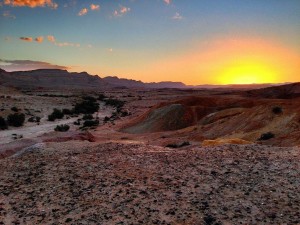After reading Mark Levine’s response to Jon Voigt’s open letter, I had to write about why many people like think as Jon Voigt does, and how political trends in Israel make his views rather quaint.

A desert in bloom
There is a lot to admire in the words, and many of the deeds, of Israeli leaders in the early years. Mapai/Labor were in charge and the kibbutz movement was ascendant. Ben-Gurion’s oft-quoted dream of making the “Negev desert bloom” is what people are thinking of when they see Israel as a project to create an oasis in the desert. The residual goodwill from that period are part of the reason an earlier generation sees the whole period with rose colored glasses and that is where Voigt is coming from (and Woody Allen as well).
Ben-Gurion’s powerful image of the desert oasis suggested a barren, sparsely populated land. This is part of the reason so many people still believe that all of Palestine was populated by nomadic tribes prior to 1948. This may have been true about the Negev Bedouin, but even they alone were over a 100,000 in 1948. In comparison, the entire Jewish population in then Palestine was around 600,000.
Of course, the West Bank is not the Negev, and neither was much of the coast with its heavily populated Palestinian villages and towns. They were both parts of a thriving Mediterranean culture that had traded with and influenced the entire area for millenia. In Palestine, there was a mixed community of Muslims and Christians, along with some Jews who had lived side by side for centuries. In 1948, that community was torn asunder in what they call the Nakba. Some 700,000 Palestinians were expelled from their homes by the Jewish militia, or fled in fear. Many of their villages were razed to the ground. It was this that moved Golda Meir to say, after a visit to Arab Haifa in 1948:
It is a dreadful thing to see the dead city. Next to the port I found children, women, the old, waiting for a way to leave. I entered the houses, there were houses where the coffee and pita bread were left on the table, and I could not avoid [thinking] that this, indeed, had been the picture in many Jewish towns [i.e., in Europe, during World War II]‘.
To come back to the desert though. The Negev Bedouin had a way of life which deserves respect. They had lived and survived on that unforgiving land for centuries. After 1948, they were forced into settlements, and thousands expelled into Jordan or Egypt. This has diminished their culture (not to mention dispossessed them of their lands). So even that ostensibly inoffensive project is more questionable than many claim. In some ways, the treatment of the Bedouin parallels our own country’s treatment of the Native American tribes living on the Great Plains.
“I have heard you intend to settle us on a reservation near the mountains. I don’t want to settle. I love to roam over the prairies. There I feel free and happy, but when we settle down we grow pale and die. A long time ago this land belonged to our fathers, but when I go up to the river I see camps of soldiers on its banks. These soldiers cut down my timber, they kill my buffalo and when I see that, my heart feels like bursting.” — Satanta, Kiowa Chief
Continue reading “What happened to Ben-Gurion’s Oasis in the Desert?”